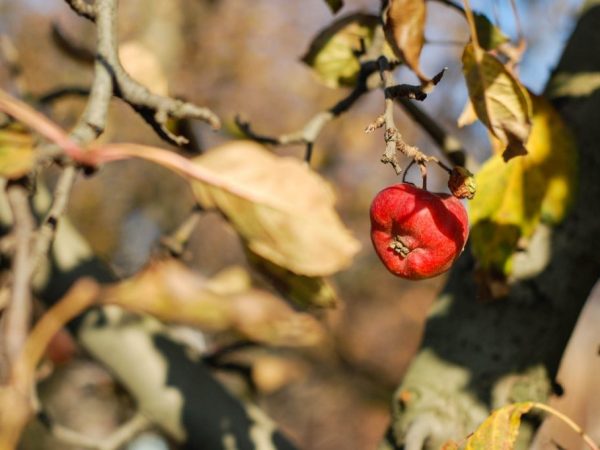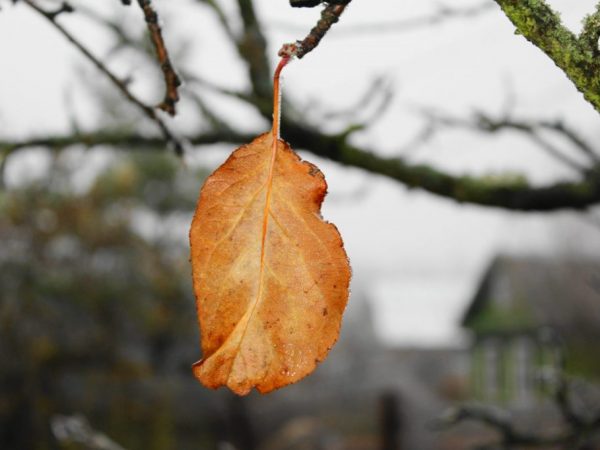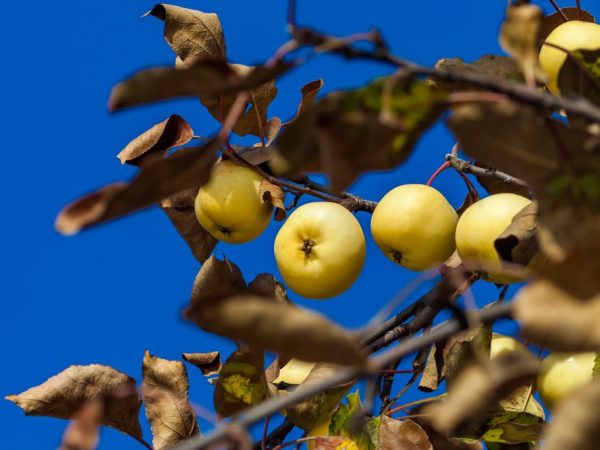Causes of drying out of branches, leaves and trunk on an apple tree
The drying up of apple trees is one of the main problems that gardeners face. This leads to significant crop losses and tree death. Let's figure out why the branches of the apple tree dry and how to reanimate a diseased plant.

The reasons for the drying out of branches and leaves on an apple tree
Causes
As practice shows, dwarf, semi-dwarf and columnar varieties are more susceptible to this phenomenon. Vigorous (seed) rootstocks have a higher resistance to drying out.
There are many reasons for this process.
Climatic conditions
Freezing of fruit crops is a frequent phenomenon caused by sharp temperature changes in winter. This usually happens in early spring.
As a rule, the bark freezes on the south side, becomes covered with black crayfish, and after a couple of years the tree dies. This is typical for apple trees grown in regions with harsh climatic conditions.
In the summer, during the season of prolonged rains, a process of partial flaking of the bark on the trunk occurs, which leads to the drying out of individual parts. This process is typical for the regions of the southern strip.
With strong or complete freezing of the root system in the regions of the Middle, Central and Northern strip, the culture completely dries out.
Landing errors
The reason for the drying out of young apple trees is non-compliance with the planting dates - usually this procedure is carried out in spring or autumn.
Some gardeners do this in the summer, making a big mistake, since the seedling has less chance of survival. In summer, the plant runs the risk of dying from lack of moisture and sunburn.
Do not plant nearby plants such as foxtail, wheatgrass, timothy - they negatively affect the health of apple trees and have a poisonous effect for them.
Soil features
Planting young plants on acidified loamy, sandy loam soil leads to their drying out. The soil should be loose, slightly acidic, enriched with organic and mineral components.
Plants planted in places with a close occurrence of groundwater often suffer from waterlogging. The root system does not receive the required amount of oxygen, from this it suffocates and begins to rot. After a while, the foliage on the tree turns yellow, the shoots wither, dry up and it dies.
Young apple trees dry out due to the lack of good drainage in the soil. In too heavy and clogged soil, the same process of suffocation of roots and drying out of the aboveground part occurs.
The cause of drying out after flowering may be damage and rotting of the roots in too waterlogged or waterlogged soil. Without access to oxygen, the roots begin to die off, the plant forms flower buds, but in small quantities, while the harvest is not as tasty and rich.
Malnutrition

With a lack of nutrients, leaves may dry out.
Lack of nutrients in the soil is another reason.There are several types of fasting:
- Nitrogen. The foliage turns yellow and dries up, and crumbles over time.
- Potash. The leaf blade has a characteristic yellow border that covers the entire leaf. The crown of the central conductor can also dry out in columnar and dwarf varieties.
- Magnesium. Yellowing and drying of the leaves occurs between the veins.
- Iron (chlorosis). The top of the shoots and the surface of the leaves acquire a yellowish tint. The same phenomenon is typical with a lack of nitrogen, potassium, manganese and with an excess of lime in the soil.
Improper grafting and pruning
When buying a seedling for planting, you should carefully inspect the grafting site - it should not have slugs and outgrowths, otherwise it will not be suitable for the future rootstock. Such a tree has a high risk of contracting a viral infection during grafting, which can lead to its drying out.
There is a great risk of drying out if pruned incorrectly in cold regions of the country. Due to inexperience, some gardeners carry out pruning on the eve of the upcoming frost - the tree does not have time to recover, freezes, and with the arrival of spring it begins to dry out.
A dried branch of an apple tree must be cut to a healthy tissue, and the places of the cuts must be treated with copper sulfate and covered with garden var. The branches that have dried up are burned, since they are the source of the development of pathogenic microflora in the area.
Diseases
Shoots, leaves, buds dry out in spring or autumn due to infection with various diseases.
- Black cancer. First, brown spots appear on the leaves, over time they turn black and transform into sores. The infection quickly spreads to other organs - skeletal branches, trunk. Over time, the apple tree is completely covered with a bloom of black. To avoid further infection, it is necessary to remove the infected parts on the tree and treat the cuts with copper sulfate. Often, only the central conductor dries out, and after that the process moves on to all other organs.
- Scab. With this sore, the leaves are primarily affected - they turn brown, dry and fall off massively.
- When affected by powdery mildew, a whitish bloom appears, which eventually darkens and takes on a brownish color. At an advanced stage, the tree stops bearing fruit and dries up completely.
- Drying of the tip on the shoots can be caused by a fungal disease - cytosporosis or black cancer. At the same time, the crown of the central conductor also dries.
- When a tree is damaged by fruit brown rot, the apples dry out. First, the fruits are covered with brown spots, then a white bloom in the form of warts. Over time, they fall off.
Pests
Sometimes the apple tree dries up due to the invasion of parasites.

Insects can kill a tree
- Ants and aphids. Small parasites that reproduce at a galloping rate suck the juices from leaves, flower and vegetative buds, which leads to their drying out. At the affected sites, the insect leaves sticky excrement, which serves as an excellent environment for the development of a sooty fungus. This infection affects all organs of the plant and at an advanced stage the tree dries up and dies.
- Caterpillars. They gnaw out the tissues of the leaves, as a result of which they twist and dry.
- The same phenomenon occurs on trees that are affected by spider mites, leaf rollers and moths.
- The apple tree often suffers from the invasion of rodents - field mice, shrews and moles. These pests gnaw the roots and bark on the trunk.
- May beetle larvae are the most dangerous pests of young apple trees. They gnaw out young roots, as a result of which the entire aerial part withers, then dries up.
Shrinking on one side
This phenomenon is possible due to improper care. A tree that dries partially, has a weak immunity, grows in clogged soil with poor moisture and air permeability, or suffers from a lack of space on the site (dense planting, close arrangement of shrubs and other fruit crops).
Under such conditions, the apple tree carries out nutritional rationing, depriving the weakest and underdeveloped branches of nutrients. Gradually, these parts die off and dry out.
How to revive a tree
Depending on the reason, gardeners use different methods of prevention and resuscitation of a dying tree:
- The crop should be planted in a sunny area with deep groundwater. When planting, drainage is introduced into the pits (pebbles, crushed stone, broken brick), which will prevent root decay and moisture stagnation. To deoxidize the soil, dolomite flour, slaked lime or powdered chalk are added to the site.
- To increase the nutritional value of the soil, the area for planting apple trees is fertilized with rotted manure, wood ash, potassium nitrate and superphosphate. These components increase the tree's immunity from various diseases and eliminate the risk of drying out of the underground and aboveground parts.
- In the regions of the Middle, Central and Northern strip, where there is a high risk of freezing of the roots and near-trunk zone, it is necessary to apply mulch from peat, humus and garden soil, and also provide trees with good shelter from spruce branches or roofing material.
- To protect trees from black cancer, it is necessary to keep the site clean, remove the affected parts in time and process the tree with copper sulfate. In the fight against scab, the drug Topaz or Hom is used, for powdery mildew - Skor. Of the folk methods for spraying sick specimens, a copper-soap solution, a soda solution, and a 1% solution of boric acid are used.
- To destroy aphids, gardeners use special pesticides - Aktar, Aktellik or folk remedies - ash-soap, tobacco-soap, garlic or pepper infusions. The treatment of the crown with karbofos will help to get rid of the caterpillars, and Nitrofen, Karbofos or Chlorophos will exterminate the spider mite, leafworm and moth. Special pesticides and traps are used against rodents.
- At an advanced stage, when the tree or seedling is half dry, a radical pruning of the tree to healthy tissue is performed, then the crown is treated with copper sulfate and fertilizing with a complex composition (superphosphate, potassium salt and azophos). Such a tree will survive if it is regularly looked after - watering, fertilizing, loosening the soil, mulching and providing good protection for the winter.
- If the reason lies in the defeat of the root system, the tree is dug up, the damaged parts are removed, sprayed with copper sulfate, allowed to dry slightly and planted in a new place with fertile, loose soil and in the area with deep passage of groundwater.
Prophylaxis
To prevent the apple tree from drying out, it is necessary to carry out a number of simple preventive measures:
- provide good protection against freezing in winter;
- create a drainage system when planting;
- observe the landing dates - in the spring (at the end of April or at the beginning of May) or in the fall (at the beginning of September);
- regularly feed the garden with fertilizers;
- in spring and autumn, treat with antifungal drugs and effective parasites;
- trim the crown correctly and in due time.
Conclusion
There are many reasons why shoots, trunk, leaves and fruits dry out on an apple tree, however, it is quite easy to exclude them. To do this, it is necessary to observe agricultural practices, provide the tree with proper care and attention. Then the garden will always be healthy and annually delight you with a delicious and abundant harvest.

